Medicinal Herbs Market
Medicinal Herbs Market Size and Share Forecast Outlook 2025 to 2035
Medicinal herbs market is projected to grow from USD 6.4 billion in 2025 to USD 9.8 billion by 2035, at a CAGR of 4.4%. Whole Dried Herbs will dominate with a 42.0% market share, while nutraceuticals will lead the application segment with a 44.0% share.
Medicinal Herbs Market Forecast and Outlook 2025 to 2035
The global medicinal herbs market is valued at USD 6.4 billion in 2025. It is slated to reach USD 9.8 billion by 2035, recording an absolute increase of USD 3.4 billion over the forecast period. This translates into a total growth of 53.1%, with the market forecast to expand at a compound annual growth rate (CAGR) of 4.4% between 2025 and 2035.
The overall market size is expected to grow by nearly 1.53X during the same period, supported by increasing consumer preference for natural health solutions, growing integration of traditional medicine with modern healthcare, rising demand for plant-based therapeutics, and expanding applications in nutraceuticals and cosmetics industries.
Quick Stats for Medicinal Herbs Market
- Medicinal Herbs Market Value (2025): USD 6.4 billion
- Medicinal Herbs Market Forecast Value (2035): USD 9.8 billion
- Medicinal Herbs Market Forecast CAGR: 4.4%
- Leading Product Type in Medicinal Herbs Market: Whole Dried Herbs
- Key Growth Regions in Medicinal Herbs Market: Asia-Pacific, North America, and Europe
- Key Players in Medicinal Herbs Market: Martin Bauer Group, Naturex, Nexira, Starwest Botanicals, Indena, Givaudan
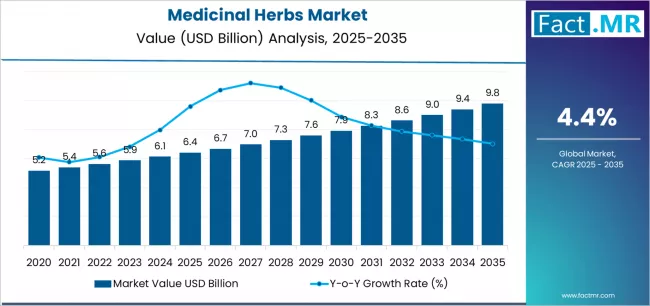
The growth of the medicinal herbs market is being driven by a global shift toward preventive healthcare and holistic wellness practices. Consumers are increasingly seeking natural remedies that offer therapeutic benefits with fewer side effects compared to synthetic drugs. This trend is complemented by the rising popularity of traditional medicine systems, such as Ayurveda, Traditional Chinese Medicine, and Unani, which rely heavily on medicinal herbs for treatment and wellness support. Integration of these practices with modern healthcare is fostering wider acceptance and demand for standardized, high-quality herbal formulations.
Nutraceuticals and dietary supplements represent a significant application segment, as herbs like ginseng, turmeric, echinacea, and ashwagandha gain traction for their antioxidant, immunity-boosting, and adaptogenic properties. The functional food and beverage industry is also incorporating medicinal herbs into teas, juices, and health shots, catering to consumers seeking convenient, plant-based wellness solutions. Additionally, the cosmetics and personal care industry is expanding the use of herbal extracts in skincare, haircare, and anti-aging products, capitalizing on the growing consumer preference for natural, chemical-free formulations.
Technological advancements in cultivation, extraction, and standardization processes are enhancing the quality, consistency, and efficacy of herbal products. Sustainable and organic farming practices are increasingly being adopted to meet consumer demand for ethically sourced, environmentally friendly ingredients. Geographically, North America and Europe remain leading markets due to high health consciousness, disposable income, and established distribution channels, while Asia-Pacific is expected to witness robust growth driven by traditional medicine prevalence, rising urbanization, and expanding middle-class populations. Overall, the medicinal herbs market is poised for steady expansion, fueled by health-conscious consumer behavior, product innovation, and growing acceptance of plant-based therapies in mainstream healthcare.
Between 2025 and 2030, the medicinal herbs market is projected to expand from USD 6.4 billion to USD 7.9 billion, resulting in a value increase of USD 1.5 billion, which represents 44.1% of the total forecast growth for the decade. This phase of development will be shaped by increasing acceptance of herbal medicine in mainstream healthcare, growing research validation of traditional remedies, and expanding commercial cultivation of medicinal plants. Herbal medicine companies and nutraceutical manufacturers are expanding their medicinal herb capabilities to address the growing demand for natural and effective health solutions.
Medicinal Herbs Market Key Takeaways
| Metric | Value |
|---|---|
| Estimated Value in (2025E) | USD 6.4 billion |
| Forecast Value in (2035F) | USD 9.8 billion |
| Forecast CAGR (2025 to 2035) | 4.4% |
From 2030 to 2035, the market is forecast to grow from USD 7.9 billion to USD 9.8 billion, adding another USD 1.9 billion, which constitutes 55.9% of the overall ten-year expansion. This period is expected to be characterized by the expansion of standardized herbal extract production, development of innovative delivery systems, and growth of personalized herbal medicine applications. The growing adoption of evidence-based herbal medicine and integration with digital health platforms will drive demand for medicinal herbs with enhanced quality standards and therapeutic validation.
Between 2020 and 2025, the medicinal herbs market experienced steady growth, driven by increasing consumer shift toward natural health solutions and growing recognition of medicinal herbs as effective alternatives to synthetic pharmaceuticals for various health conditions. The market developed as consumers and healthcare practitioners recognized the potential for medicinal herbs to support health maintenance, address chronic conditions, and provide holistic wellness solutions while minimizing side effects and supporting sustainable healthcare approaches.
Why is the Medicinal Herbs Market Growing?
Market expansion is being supported by the increasing consumer preference for natural and holistic health solutions driven by wellness consciousness and skepticism toward synthetic pharmaceuticals, alongside the corresponding need for effective plant-based therapeutics that can address various health conditions, support preventive healthcare, and provide sustainable treatment options across diverse therapeutic applications and consumer demographics. Modern healthcare providers and wellness companies are increasingly focused on implementing medicinal herb solutions that can complement conventional treatments, address chronic health conditions, and provide evidence-based natural alternatives while maintaining safety and efficacy standards.
The growing emphasis on preventive healthcare and integrative medicine is driving demand for medicinal herbs that can support long-term health maintenance, enhance immune function, and ensure comprehensive wellness support. Healthcare practitioners' preference for treatments that combine traditional wisdom with scientific validation and minimal side effects is creating opportunities for innovative medicinal herb implementations.
The rising influence of sustainable healthcare practices and environmental consciousness is also contributing to increased adoption of medicinal herbs that can provide superior therapeutic benefits without compromising environmental sustainability or contributing to pharmaceutical pollution.
Segmental Analysis
The market is segmented by product type, application, and distribution channel. By product type, the market is divided into whole dried herbs, extracts, and oils. Based on application, the market is categorized into nutraceuticals, OTC remedies, and cosmetics & others. By distribution channel, the market is segmented into B2B ingredients, retail, and online channels.
By Product Type, the Whole Dried Herbs Segment Leads the Market
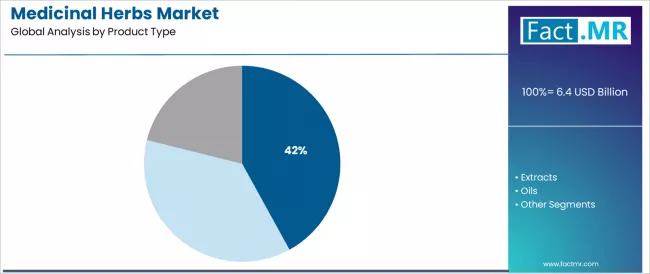
The whole dried herbs segment is projected to maintain its leading position in the medicinal herbs market in 2025 with a 42.0% market share, reaffirming its role as the preferred product form for medicinal herb consumption and traditional healing applications.
Herbal medicine practitioners and consumers increasingly utilize whole dried herbs for their complete phytochemical profiles, traditional preparation methods, and proven effectiveness in delivering comprehensive therapeutic benefits while maintaining natural integrity and cultural authenticity.
Whole dried herb technology's proven effectiveness and traditional acceptance directly address market requirements for authentic herbal medicine and established therapeutic practices across diverse healing traditions and consumer applications.
This product segment forms the foundation of traditional herbal medicine, as it represents the form with the greatest contribution to authentic healing practices and established consumer recognition across multiple cultural traditions and therapeutic contexts.
Herbal medicine industry investments in quality whole herb production continue to strengthen adoption among practitioners and consumers. With healing traditions requiring authentic and complete herbal preparations, whole dried herbs align with both therapeutic objectives and traditional medicine requirements, making them the central component of comprehensive medicinal herb strategies.
By Application, the Nutraceuticals Segment Dominates Market Demand
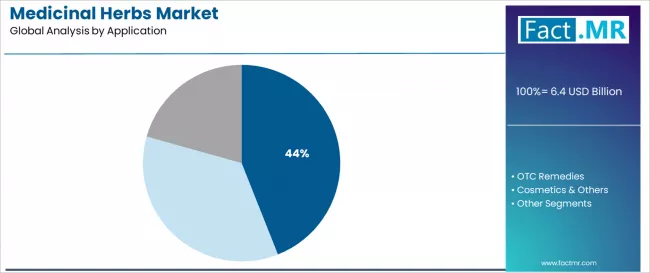
The nutraceuticals application segment is projected to represent the largest share of medicinal herbs demand in 2025 with a 44.0% market share, underscoring its critical role as the primary driver for medicinal herb adoption across dietary supplements, functional foods, and health maintenance products.
Manufacturers prefer medicinal herbs for nutraceutical applications due to their proven health benefits, consumer acceptance, and ability to support various health claims while maintaining natural positioning and regulatory compliance. Positioned as essential ingredients for natural health products, medicinal herbs offer both therapeutic advantages and consumer appeal benefits.
The segment is supported by continuous research in herbal medicine science and the growing availability of standardized herbal extracts that enable superior product consistency with enhanced bioavailability and therapeutic effectiveness.
Additionally, nutraceutical manufacturers are investing in comprehensive quality assurance programs to support increasingly sophisticated medicinal herb offerings and consumer health optimization requirements. As natural health awareness increases and preventive care advances, the nutraceuticals application will continue to dominate the market while supporting advanced formulation strategies and consumer wellness optimization.
What are the Drivers, Restraints, and Key Trends of the Medicinal Herbs Market?
The medicinal herbs market is advancing steadily due to increasing consumer preference for natural health solutions driven by wellness consciousness and side-effect concerns with synthetic drugs, alongside growing scientific validation of traditional medicinal herbs that provide therapeutic benefits, support preventive healthcare, and enable integrative medicine approaches across various health conditions and therapeutic applications.
However, the market faces challenges, including quality standardization issues across suppliers, regulatory variations for herbal products, and sustainability concerns about wild harvesting practices. Innovation in cultivation methods and extraction technologies continues to influence product quality and market expansion patterns.
Expansion of Integrative Medicine and Healthcare Integration
The growing acceptance of integrative medicine is driving demand for medicinal herbs that can complement conventional treatments, enhance therapeutic outcomes, and provide holistic health support through evidence-based herbal therapies and traditional healing wisdom.
Healthcare practitioners require scientifically validated medicinal herb solutions that deliver proven therapeutic benefits across multiple health conditions while maintaining safety profiles and regulatory compliance.
Medical institutions are increasingly recognizing the competitive advantages of herbal medicine integration for patient satisfaction and treatment effectiveness, creating opportunities for specialized herbal products designed for clinical applications and healthcare integration.
Integration of Sustainable Cultivation and Quality Standardization
Modern medicinal herb producers are incorporating sustainable cultivation practices and advanced quality standardization methods to enhance product consistency, ensure therapeutic potency, and support comprehensive sustainability objectives through organic farming, good agricultural practices, and supply chain traceability.
Leading companies are developing sustainable cultivation programs, implementing quality control systems, and advancing processing technologies that maintain therapeutic effectiveness while ensuring environmental responsibility and social sustainability. These practices improve product quality while enabling new market opportunities, including certified organic herbs, fair trade products, and environmentally conscious health solutions.
Development of Advanced Extraction and Delivery Technologies
The expansion of extraction science and delivery technology is driving demand for advanced medicinal herb products with enhanced bioavailability, standardized potency, and optimized therapeutic effectiveness through innovative processing methods and formulation techniques.
These advanced herbal products require sophisticated extraction capabilities and quality control systems that exceed traditional herbal processing requirements, creating premium market segments with differentiated value propositions. Manufacturers are investing in extraction research and processing technology to serve emerging therapeutic applications while supporting innovation in personalized herbal medicine and targeted wellness solutions.
Analysis of the Medicinal Herbs Market by Key Countries
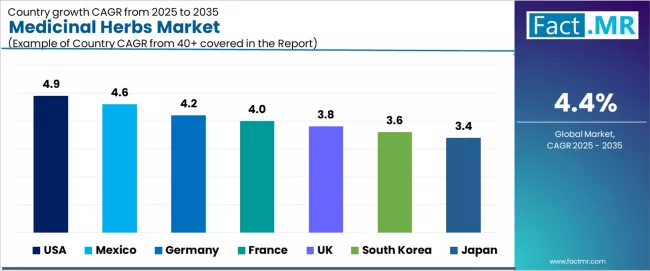
| Country | CAGR (2025-2035) |
|---|---|
| USA | 4.9% |
| Mexico | 4.6% |
| Germany | 4.2% |
| France | 4.0% |
| UK | 3.8% |
| South Korea | 3.6% |
| Japan | 3.4% |
The medicinal herbs market is experiencing solid growth globally, with the USA leading at a 4.9% CAGR through 2035, driven by extensive natural health market development, growing integrative medicine adoption, and increasing consumer preference for plant-based therapeutics supporting medicinal herb utilization. Mexico follows at 4.6%, supported by rich traditional medicine heritage, expanding natural product industries, and growing commercial cultivation of medicinal plants.
Germany shows growth at 4.2%, emphasizing quality standards, scientific validation, and comprehensive herbal medicine integration. France demonstrates 4.0% growth, supported by herbal medicine traditions, quality consciousness, and natural health approaches.
The UK records 3.8%, focusing on natural health trends, herbal supplement adoption, and wellness-oriented consumption. South Korea exhibits 3.6% growth, emphasizing traditional medicine integration and premium herbal products. Japan shows 3.4% growth, supported by traditional medicine culture and quality herbal preparations.
USA Leads Global Market Growth with Natural Health Innovation

Revenue from medicinal herbs in the USA is projected to exhibit strong growth with a CAGR of 4.9% through 2035, driven by extensive natural health market development and rapidly growing integrative medicine adoption supporting medicinal herb utilization among healthcare practitioners, wellness consumers, and natural product manufacturers.
The country's established nutraceutical industry infrastructure and increasing consumer preference for natural alternatives are creating substantial demand for medicinal herb solutions. Major herbal medicine companies and natural product manufacturers are establishing comprehensive research and cultivation capabilities to serve both domestic markets and export opportunities.
- Strong natural health consciousness and integrative medicine trends are driving demand for medicinal herbs throughout health food stores, pharmacies, and wellness centers across urban markets, health-conscious communities, and medical facilities offering complementary therapies.
- Growing scientific research and healthcare professional acceptance are supporting the rapid adoption of medicinal herbs among consumers and practitioners seeking evidence-based natural alternatives and therapeutic effectiveness for various health conditions and wellness applications.
Mexico Demonstrates Strong Market Potential with Traditional Medicine Heritage
Revenue from medicinal herbs in Mexico is expanding at a CAGR of 4.6%, supported by the country's rich traditional medicine heritage, extensive biodiversity of medicinal plants, and growing commercial cultivation and processing industries for both domestic and international markets.
The country's traditional knowledge base and agricultural capabilities are driving sophisticated medicinal herb production throughout diverse regions and cultural communities. Leading herbal medicine companies and agricultural enterprises are establishing comprehensive cultivation and processing facilities to address growing regional and export demand.
- Rich traditional medicine knowledge and abundant medicinal plant biodiversity are creating opportunities for medicinal herb development across rural communities, agricultural regions, and traditional medicine practitioners serving domestic and international markets.
- Growing commercial cultivation and processing industries are driving adoption of sustainable harvesting practices and quality standardization among producers seeking enhanced market access and premium positioning for traditional medicinal herbs.
Germany Demonstrates Scientific Excellence with Quality Leadership
Revenue from medicinal herbs in Germany is expanding at a CAGR of 4.2%, driven by the country's emphasis on scientific validation, stringent quality standards, and comprehensive integration of herbal medicine into healthcare systems supporting evidence-based medicinal herb adoption.
Germany's regulatory rigor and research capabilities are driving demand for high-quality medicinal herb solutions. Leading pharmaceutical and herbal medicine companies are establishing comprehensive quality development programs for scientifically validated herbal products.
- Advanced quality standards and scientific validation requirements are creating demand for premium medicinal herbs among healthcare providers, pharmaceutical companies, and health-conscious consumers seeking evidence-based therapeutic effectiveness and safety assurance.
- Strong pharmaceutical expertise and herbal medicine research are supporting the adoption of clinically validated medicinal herbs across medical facilities, pharmacies, and specialized herbal medicine centers throughout major healthcare and research regions.
France Focuses on Traditional Excellence and Quality Consciousness
Revenue from medicinal herbs in France is expanding at a CAGR of 4.0%, driven by the country's herbal medicine traditions, quality consciousness culture, and comprehensive approach to natural health and wellness supporting medicinal herb integration into French healthcare and wellness practices.
France's healthcare sophistication and natural product appreciation are supporting investment in premium medicinal herb positioning. Major health companies and traditional medicine practitioners are establishing comprehensive innovation programs incorporating medicinal herbs with French health approaches.
- Advanced healthcare consciousness and traditional medicine appreciation are creating demand for medicinal herbs throughout pharmacies, health practitioners, and wellness centers serving health-focused consumer segments and traditional medicine applications.
- Strong quality consciousness and natural health trends are driving the adoption of premium medicinal herbs across healthcare channels, wellness programs, and traditional medicine practices throughout major metropolitan and healthcare regions.
UK Shows Market Leadership with Natural Health Integration
Revenue from medicinal herbs in the UK is expanding at a CAGR of 3.8%, supported by the country's natural health trends, herbal supplement adoption, and growing integration of complementary therapies into healthcare systems supporting medicinal herb utilization across wellness and therapeutic applications.
The UK's wellness market maturity and healthcare innovation are driving demand for scientifically supported medicinal herb solutions. Leading health companies and wellness practitioners are investing in herbal medicine development and natural health positioning for health-conscious consumers.
- Advanced natural health trends and complementary therapy integration are creating opportunities for medicinal herbs throughout health retailers, wellness practitioners, and healthcare facilities serving natural health-focused consumer segments and therapeutic applications.
- Strong herbal supplement market and wellness focus are driving the adoption of medicinal herbs across natural health channels, complementary medicine practices, and wellness-oriented healthcare services targeting holistic health consumers.
South Korea Demonstrates Traditional Leadership with Modern Integration
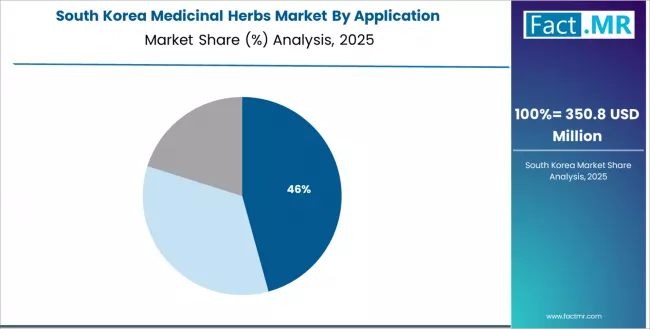
Revenue from medicinal herbs in South Korea is expanding at a CAGR of 3.6%, supported by the country's traditional medicine heritage, modern healthcare integration, and strong emphasis on quality herbal products and traditional healing practices supporting advanced medicinal herb adoption.
The nation's traditional medicine sophistication and quality consciousness are driving demand for premium medicinal herb solutions. Leading traditional medicine companies are investing extensively in quality herbal product development and traditional medicine market expansion.
- Advanced traditional medicine integration and quality herbal product focus are creating demand for medicinal herbs throughout traditional medicine clinics, healthcare facilities, and premium health stores serving traditional medicine practitioners and health-conscious consumers.
- Strong traditional healing practices and modern healthcare integration are supporting the adoption of medicinal herbs designed for traditional therapeutic applications, modern wellness support, and comprehensive health maintenance across diverse consumer demographics.
Japan Shows Premium Focus with Traditional Medicine Applications

Revenue from medicinal herbs in Japan is expanding at a CAGR of 3.4%, supported by the country's traditional medicine culture, quality herbal preparation standards, and strong emphasis on authentic medicinal herbs and traditional healing practices supporting high-quality herbal medicine adoption.
Japan's quality consciousness and traditional medicine expertise are driving demand for premium medicinal herb products. Leading traditional medicine and pharmaceutical companies are investing in specialized capabilities for quality herbal preparations and traditional medicine applications.
- Advanced traditional medicine culture and quality preparation standards are creating opportunities for medicinal herbs throughout traditional medicine practitioners, specialty pharmacies, and quality-focused health retailers serving traditional medicine consumers and health-conscious segments.
- Strong quality consciousness and traditional medicine focus are driving adoption of premium medicinal herbs meeting Japanese consumer expectations for authenticity, therapeutic effectiveness, and comprehensive quality assurance across diverse traditional medicine and wellness applications.
Europe Market Split by Country
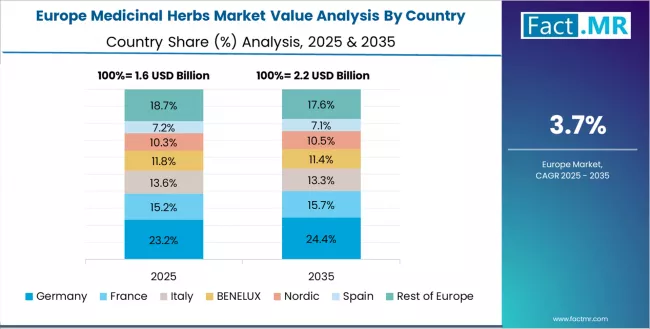
The medicinal herbs market in Europe is projected to grow from USD 1.8 billion in 2025 to USD 2.7 billion by 2035, registering a CAGR of 4.1% over the forecast period. Germany is expected to maintain leadership with a 31.1% market share in 2025, moderating to 30.8% by 2035, supported by scientific validation emphasis, stringent quality standards, and comprehensive herbal medicine integration into healthcare systems.
France follows with 23.9% in 2025, projected to reach 24.1% by 2035, driven by herbal medicine traditions, quality consciousness culture, and natural health approaches supporting medicinal herb adoption. The United Kingdom holds 19.4% in 2025, expected to reach 19.6% by 2035 due to natural health trends and complementary therapy integration.
Italy commands 14.4% in 2025, rising to 14.5% by 2035, while Spain accounts for 7.2% in 2025, reaching 7.3% by 2035. The Rest of Europe region is anticipated to hold 4.0% in 2025 and 3.7% by 2035, reflecting steady medicinal herb market development in Nordic countries and emerging traditional medicine markets in Eastern European countries with rich herbal traditions.
Competitive Landscape of the Medicinal Herbs Market
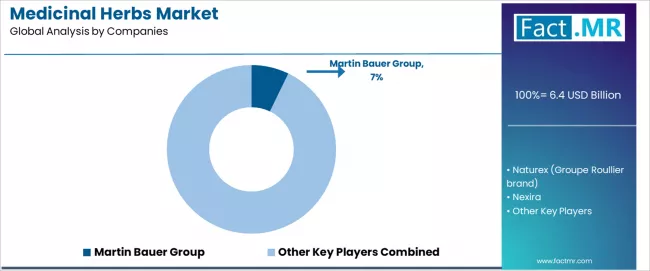
The medicinal herbs market is characterized by competition among established herbal medicine companies, natural product manufacturers, and specialized botanical ingredient suppliers. Companies are investing in sustainable cultivation technology development, quality standardization systems, scientific research validation, and supply chain optimization to deliver effective, safe, and traceable medicinal herb solutions. Innovation in extraction techniques, standardization methods, and therapeutic validation is central to strengthening market position and competitive advantage.
Martin Bauer Group leads the market with a 7.2% share, offering comprehensive medicinal herb solutions with focus on quality assurance, sustainable sourcing, and extensive botanical expertise across diverse therapeutic and commercial applications. The company continues investing in cultivation partnerships, extraction capabilities, and quality control systems while expanding global supply networks and technical service capabilities.
Naturex provides innovative botanical ingredient solutions with emphasis on extraction technology and standardization. Nexira specializes in plant-based ingredients with functional benefits. Starwest Botanicals focuses on organic and wildcrafted herb supply. Indena emphasizes pharmaceutical-grade botanical extracts. Givaudan offers flavor and fragrance applications for botanical ingredients.
Key Players in the Medicinal Herbs Market
- Martin Bauer Group
- Naturex (Groupe Roullier brand)
- Nexira
- Starwest Botanicals, Inc.
- Indena S.p.A.
- Givaudan SA
- GA Herb Co., Ltd.
- Amega Sciences, Inc.
- Afriplex
- Himalaya Wellness Company
Scope of the Report
| Items | Values |
|---|---|
| Quantitative Units (2025) | USD 6.4 Billion |
| Product Type | Whole Dried Herbs, Extracts, Oils |
| Application | Nutraceuticals, OTC Remedies, Cosmetics & Others |
| Distribution Channel | B2B Ingredients, Retail, Online |
| Regions Covered | North America, Europe, Asia-Pacific, Latin America, Middle East & Africa |
| Countries Covered | USA, Mexico, Germany, France, UK, Japan, South Korea, and 40+ countries |
| Key Companies Profiled | Martin Bauer Group, Naturex, Nexira, Starwest Botanicals, Indena, Givaudan |
| Additional Attributes | Dollar sales by product type and application, regional demand trends, competitive landscape, sustainable cultivation development, quality standardization advancement, therapeutic validation research, and traditional medicine integration optimization |
Medicinal Herbs Market by Segments
-
Product Type :
- Whole Dried Herbs
- Extracts
- Oils
-
Application :
- Nutraceuticals
- OTC Remedies
- Cosmetics & Others
-
Distribution Channel :
- B2B Ingredients
- Retail
- Online
-
Region :
-
North America
- United States
- Canada
- Mexico
-
Europe
- Germany
- United Kingdom
- France
- Italy
- Spain
- Netherlands
- Rest of Europe
-
Asia-Pacific
- Japan
- South Korea
- China
- India
- Australia
- Rest of Asia-Pacific
-
Latin America
- Brazil
- Argentina
- Rest of Latin America
-
Middle East & Africa
- Kingdom of Saudi Arabia
- South Africa
- Rest of Middle East & Africa
-
Table of Content
- Executive Summary
- Global Market Outlook
- Demand to side Trends
- Supply to side Trends
- Technology Roadmap Analysis
- Analysis and Recommendations
- Market Overview
- Market Coverage / Taxonomy
- Market Definition / Scope / Limitations
- Market Background
- Market Dynamics
- Drivers
- Restraints
- Opportunity
- Trends
- Scenario Forecast
- Demand in Optimistic Scenario
- Demand in Likely Scenario
- Demand in Conservative Scenario
- Opportunity Map Analysis
- Product Life Cycle Analysis
- Supply Chain Analysis
- Investment Feasibility Matrix
- Value Chain Analysis
- PESTLE and Porter’s Analysis
- Regulatory Landscape
- Regional Parent Market Outlook
- Production and Consumption Statistics
- Import and Export Statistics
- Market Dynamics
- Global Market Analysis 2020 to 2024 and Forecast, 2025 to 2035
- Historical Market Size Value (USD Million) Analysis, 2020 to 2024
- Current and Future Market Size Value (USD Million) Projections, 2025 to 2035
- Y to o to Y Growth Trend Analysis
- Absolute $ Opportunity Analysis
- Global Market Pricing Analysis 2020 to 2024 and Forecast 2025 to 2035
- Global Market Analysis 2020 to 2024 and Forecast 2025 to 2035, By Product Type
- Introduction / Key Findings
- Historical Market Size Value (USD Million) Analysis By Product Type , 2020 to 2024
- Current and Future Market Size Value (USD Million) Analysis and Forecast By Product Type , 2025 to 2035
- Whole Dried Herbs
- Extracts
- Oils
- Y to o to Y Growth Trend Analysis By Product Type , 2020 to 2024
- Absolute $ Opportunity Analysis By Product Type , 2025 to 2035
- Global Market Analysis 2020 to 2024 and Forecast 2025 to 2035, By Application
- Introduction / Key Findings
- Historical Market Size Value (USD Million) Analysis By Application, 2020 to 2024
- Current and Future Market Size Value (USD Million) Analysis and Forecast By Application, 2025 to 2035
- Nutraceuticals
- OTC Remedies
- Cosmetics & Others
- Y to o to Y Growth Trend Analysis By Application, 2020 to 2024
- Absolute $ Opportunity Analysis By Application, 2025 to 2035
- Global Market Analysis 2020 to 2024 and Forecast 2025 to 2035, By Region
- Introduction
- Historical Market Size Value (USD Million) Analysis By Region, 2020 to 2024
- Current Market Size Value (USD Million) Analysis and Forecast By Region, 2025 to 2035
- North America
- Latin America
- Western Europe
- Eastern Europe
- East Asia
- South Asia and Pacific
- Middle East & Africa
- Market Attractiveness Analysis By Region
- North America Market Analysis 2020 to 2024 and Forecast 2025 to 2035, By Country
- Historical Market Size Value (USD Million) Trend Analysis By Market Taxonomy, 2020 to 2024
- Market Size Value (USD Million) Forecast By Market Taxonomy, 2025 to 2035
- By Country
- USA
- Canada
- Mexico
- By Product Type
- By Application
- By Country
- Market Attractiveness Analysis
- By Country
- By Product Type
- By Application
- Key Takeaways
- Latin America Market Analysis 2020 to 2024 and Forecast 2025 to 2035, By Country
- Historical Market Size Value (USD Million) Trend Analysis By Market Taxonomy, 2020 to 2024
- Market Size Value (USD Million) Forecast By Market Taxonomy, 2025 to 2035
- By Country
- Brazil
- Chile
- Rest of Latin America
- By Product Type
- By Application
- By Country
- Market Attractiveness Analysis
- By Country
- By Product Type
- By Application
- Key Takeaways
- Western Europe Market Analysis 2020 to 2024 and Forecast 2025 to 2035, By Country
- Historical Market Size Value (USD Million) Trend Analysis By Market Taxonomy, 2020 to 2024
- Market Size Value (USD Million) Forecast By Market Taxonomy, 2025 to 2035
- By Country
- Germany
- UK
- Italy
- Spain
- France
- Nordic
- BENELUX
- Rest of Western Europe
- By Product Type
- By Application
- By Country
- Market Attractiveness Analysis
- By Country
- By Product Type
- By Application
- Key Takeaways
- Eastern Europe Market Analysis 2020 to 2024 and Forecast 2025 to 2035, By Country
- Historical Market Size Value (USD Million) Trend Analysis By Market Taxonomy, 2020 to 2024
- Market Size Value (USD Million) Forecast By Market Taxonomy, 2025 to 2035
- By Country
- Russia
- Poland
- Hungary
- Balkan & Baltic
- Rest of Eastern Europe
- By Product Type
- By Application
- By Country
- Market Attractiveness Analysis
- By Country
- By Product Type
- By Application
- Key Takeaways
- East Asia Market Analysis 2020 to 2024 and Forecast 2025 to 2035, By Country
- Historical Market Size Value (USD Million) Trend Analysis By Market Taxonomy, 2020 to 2024
- Market Size Value (USD Million) Forecast By Market Taxonomy, 2025 to 2035
- By Country
- China
- Japan
- South Korea
- By Product Type
- By Application
- By Country
- Market Attractiveness Analysis
- By Country
- By Product Type
- By Application
- Key Takeaways
- South Asia and Pacific Market Analysis 2020 to 2024 and Forecast 2025 to 2035, By Country
- Historical Market Size Value (USD Million) Trend Analysis By Market Taxonomy, 2020 to 2024
- Market Size Value (USD Million) Forecast By Market Taxonomy, 2025 to 2035
- By Country
- India
- ASEAN
- Australia & New Zealand
- Rest of South Asia and Pacific
- By Product Type
- By Application
- By Country
- Market Attractiveness Analysis
- By Country
- By Product Type
- By Application
- Key Takeaways
- Middle East & Africa Market Analysis 2020 to 2024 and Forecast 2025 to 2035, By Country
- Historical Market Size Value (USD Million) Trend Analysis By Market Taxonomy, 2020 to 2024
- Market Size Value (USD Million) Forecast By Market Taxonomy, 2025 to 2035
- By Country
- Kingdom of Saudi Arabia
- Other GCC Countries
- Turkiye
- South Africa
- Other African Union
- Rest of Middle East & Africa
- By Product Type
- By Application
- By Country
- Market Attractiveness Analysis
- By Country
- By Product Type
- By Application
- Key Takeaways
- Key Countries Market Analysis
- USA
- Pricing Analysis
- Market Share Analysis, 2024
- By Product Type
- By Application
- Canada
- Pricing Analysis
- Market Share Analysis, 2024
- By Product Type
- By Application
- Mexico
- Pricing Analysis
- Market Share Analysis, 2024
- By Product Type
- By Application
- Brazil
- Pricing Analysis
- Market Share Analysis, 2024
- By Product Type
- By Application
- Chile
- Pricing Analysis
- Market Share Analysis, 2024
- By Product Type
- By Application
- Germany
- Pricing Analysis
- Market Share Analysis, 2024
- By Product Type
- By Application
- UK
- Pricing Analysis
- Market Share Analysis, 2024
- By Product Type
- By Application
- Italy
- Pricing Analysis
- Market Share Analysis, 2024
- By Product Type
- By Application
- Spain
- Pricing Analysis
- Market Share Analysis, 2024
- By Product Type
- By Application
- France
- Pricing Analysis
- Market Share Analysis, 2024
- By Product Type
- By Application
- India
- Pricing Analysis
- Market Share Analysis, 2024
- By Product Type
- By Application
- ASEAN
- Pricing Analysis
- Market Share Analysis, 2024
- By Product Type
- By Application
- Australia & New Zealand
- Pricing Analysis
- Market Share Analysis, 2024
- By Product Type
- By Application
- China
- Pricing Analysis
- Market Share Analysis, 2024
- By Product Type
- By Application
- Japan
- Pricing Analysis
- Market Share Analysis, 2024
- By Product Type
- By Application
- South Korea
- Pricing Analysis
- Market Share Analysis, 2024
- By Product Type
- By Application
- Russia
- Pricing Analysis
- Market Share Analysis, 2024
- By Product Type
- By Application
- Poland
- Pricing Analysis
- Market Share Analysis, 2024
- By Product Type
- By Application
- Hungary
- Pricing Analysis
- Market Share Analysis, 2024
- By Product Type
- By Application
- Kingdom of Saudi Arabia
- Pricing Analysis
- Market Share Analysis, 2024
- By Product Type
- By Application
- Turkiye
- Pricing Analysis
- Market Share Analysis, 2024
- By Product Type
- By Application
- South Africa
- Pricing Analysis
- Market Share Analysis, 2024
- By Product Type
- By Application
- USA
- Market Structure Analysis
- Competition Dashboard
- Competition Benchmarking
- Market Share Analysis of Top Players
- By Regional
- By Product Type
- By Application
- Competition Analysis
- Competition Deep Dive
- Martin Bauer Group
- Overview
- Product Portfolio
- Profitability by Market Segments (Product/Age /Sales Channel/Region)
- Sales Footprint
- Strategy Overview
- Marketing Strategy
- Product Strategy
- Channel Strategy
- Naturex (Groupe Roullier brand)
- Nexira
- Starwest Botanicals, Inc.
- Indena S.p.A.
- Givaudan SA
- GA Herb Co., Ltd.
- Amega Sciences, Inc.
- Afriplex
- Himalaya Wellness Company
- Martin Bauer Group
- Competition Deep Dive
- Assumptions & Acronyms Used
- Research Methodology
List Of Table
- Table 1: Global Market Value (USD Million) Forecast by Region, 2020 to 2035
- Table 2: Global Market Value (USD Million) Forecast by Product Type , 2020 to 2035
- Table 3: Global Market Value (USD Million) Forecast by Application, 2020 to 2035
- Table 4: North America Market Value (USD Million) Forecast by Country, 2020 to 2035
- Table 5: North America Market Value (USD Million) Forecast by Product Type , 2020 to 2035
- Table 6: North America Market Value (USD Million) Forecast by Application, 2020 to 2035
- Table 7: Latin America Market Value (USD Million) Forecast by Country, 2020 to 2035
- Table 8: Latin America Market Value (USD Million) Forecast by Product Type , 2020 to 2035
- Table 9: Latin America Market Value (USD Million) Forecast by Application, 2020 to 2035
- Table 10: Western Europe Market Value (USD Million) Forecast by Country, 2020 to 2035
- Table 11: Western Europe Market Value (USD Million) Forecast by Product Type , 2020 to 2035
- Table 12: Western Europe Market Value (USD Million) Forecast by Application, 2020 to 2035
- Table 13: Eastern Europe Market Value (USD Million) Forecast by Country, 2020 to 2035
- Table 14: Eastern Europe Market Value (USD Million) Forecast by Product Type , 2020 to 2035
- Table 15: Eastern Europe Market Value (USD Million) Forecast by Application, 2020 to 2035
- Table 16: East Asia Market Value (USD Million) Forecast by Country, 2020 to 2035
- Table 17: East Asia Market Value (USD Million) Forecast by Product Type , 2020 to 2035
- Table 18: East Asia Market Value (USD Million) Forecast by Application, 2020 to 2035
- Table 19: South Asia and Pacific Market Value (USD Million) Forecast by Country, 2020 to 2035
- Table 20: South Asia and Pacific Market Value (USD Million) Forecast by Product Type , 2020 to 2035
- Table 21: South Asia and Pacific Market Value (USD Million) Forecast by Application, 2020 to 2035
- Table 22: Middle East & Africa Market Value (USD Million) Forecast by Country, 2020 to 2035
- Table 23: Middle East & Africa Market Value (USD Million) Forecast by Product Type , 2020 to 2035
- Table 24: Middle East & Africa Market Value (USD Million) Forecast by Application, 2020 to 2035
List Of Figures
- Figure 1: Global Market Pricing Analysis
- Figure 2: Global Market Value (USD Million) Forecast 2020-2035
- Figure 3: Global Market Value Share and BPS Analysis by Product Type , 2025 and 2035
- Figure 4: Global Market Y to o to Y Growth Comparison by Product Type , 2025-2035
- Figure 5: Global Market Attractiveness Analysis by Product Type
- Figure 6: Global Market Value Share and BPS Analysis by Application, 2025 and 2035
- Figure 7: Global Market Y to o to Y Growth Comparison by Application, 2025-2035
- Figure 8: Global Market Attractiveness Analysis by Application
- Figure 9: Global Market Value (USD Million) Share and BPS Analysis by Region, 2025 and 2035
- Figure 10: Global Market Y to o to Y Growth Comparison by Region, 2025-2035
- Figure 11: Global Market Attractiveness Analysis by Region
- Figure 12: North America Market Incremental Dollar Opportunity, 2025-2035
- Figure 13: Latin America Market Incremental Dollar Opportunity, 2025-2035
- Figure 14: Western Europe Market Incremental Dollar Opportunity, 2025-2035
- Figure 15: Eastern Europe Market Incremental Dollar Opportunity, 2025-2035
- Figure 16: East Asia Market Incremental Dollar Opportunity, 2025-2035
- Figure 17: South Asia and Pacific Market Incremental Dollar Opportunity, 2025-2035
- Figure 18: Middle East & Africa Market Incremental Dollar Opportunity, 2025-2035
- Figure 19: North America Market Value Share and BPS Analysis by Country, 2025 and 2035
- Figure 20: North America Market Value Share and BPS Analysis by Product Type , 2025 and 2035
- Figure 21: North America Market Y to o to Y Growth Comparison by Product Type , 2025-2035
- Figure 22: North America Market Attractiveness Analysis by Product Type
- Figure 23: North America Market Value Share and BPS Analysis by Application, 2025 and 2035
- Figure 24: North America Market Y to o to Y Growth Comparison by Application, 2025-2035
- Figure 25: North America Market Attractiveness Analysis by Application
- Figure 26: Latin America Market Value Share and BPS Analysis by Country, 2025 and 2035
- Figure 27: Latin America Market Value Share and BPS Analysis by Product Type , 2025 and 2035
- Figure 28: Latin America Market Y to o to Y Growth Comparison by Product Type , 2025-2035
- Figure 29: Latin America Market Attractiveness Analysis by Product Type
- Figure 30: Latin America Market Value Share and BPS Analysis by Application, 2025 and 2035
- Figure 31: Latin America Market Y to o to Y Growth Comparison by Application, 2025-2035
- Figure 32: Latin America Market Attractiveness Analysis by Application
- Figure 33: Western Europe Market Value Share and BPS Analysis by Country, 2025 and 2035
- Figure 34: Western Europe Market Value Share and BPS Analysis by Product Type , 2025 and 2035
- Figure 35: Western Europe Market Y to o to Y Growth Comparison by Product Type , 2025-2035
- Figure 36: Western Europe Market Attractiveness Analysis by Product Type
- Figure 37: Western Europe Market Value Share and BPS Analysis by Application, 2025 and 2035
- Figure 38: Western Europe Market Y to o to Y Growth Comparison by Application, 2025-2035
- Figure 39: Western Europe Market Attractiveness Analysis by Application
- Figure 40: Eastern Europe Market Value Share and BPS Analysis by Country, 2025 and 2035
- Figure 41: Eastern Europe Market Value Share and BPS Analysis by Product Type , 2025 and 2035
- Figure 42: Eastern Europe Market Y to o to Y Growth Comparison by Product Type , 2025-2035
- Figure 43: Eastern Europe Market Attractiveness Analysis by Product Type
- Figure 44: Eastern Europe Market Value Share and BPS Analysis by Application, 2025 and 2035
- Figure 45: Eastern Europe Market Y to o to Y Growth Comparison by Application, 2025-2035
- Figure 46: Eastern Europe Market Attractiveness Analysis by Application
- Figure 47: East Asia Market Value Share and BPS Analysis by Country, 2025 and 2035
- Figure 48: East Asia Market Value Share and BPS Analysis by Product Type , 2025 and 2035
- Figure 49: East Asia Market Y to o to Y Growth Comparison by Product Type , 2025-2035
- Figure 50: East Asia Market Attractiveness Analysis by Product Type
- Figure 51: East Asia Market Value Share and BPS Analysis by Application, 2025 and 2035
- Figure 52: East Asia Market Y to o to Y Growth Comparison by Application, 2025-2035
- Figure 53: East Asia Market Attractiveness Analysis by Application
- Figure 54: South Asia and Pacific Market Value Share and BPS Analysis by Country, 2025 and 2035
- Figure 55: South Asia and Pacific Market Value Share and BPS Analysis by Product Type , 2025 and 2035
- Figure 56: South Asia and Pacific Market Y to o to Y Growth Comparison by Product Type , 2025-2035
- Figure 57: South Asia and Pacific Market Attractiveness Analysis by Product Type
- Figure 58: South Asia and Pacific Market Value Share and BPS Analysis by Application, 2025 and 2035
- Figure 59: South Asia and Pacific Market Y to o to Y Growth Comparison by Application, 2025-2035
- Figure 60: South Asia and Pacific Market Attractiveness Analysis by Application
- Figure 61: Middle East & Africa Market Value Share and BPS Analysis by Country, 2025 and 2035
- Figure 62: Middle East & Africa Market Value Share and BPS Analysis by Product Type , 2025 and 2035
- Figure 63: Middle East & Africa Market Y to o to Y Growth Comparison by Product Type , 2025-2035
- Figure 64: Middle East & Africa Market Attractiveness Analysis by Product Type
- Figure 65: Middle East & Africa Market Value Share and BPS Analysis by Application, 2025 and 2035
- Figure 66: Middle East & Africa Market Y to o to Y Growth Comparison by Application, 2025-2035
- Figure 67: Middle East & Africa Market Attractiveness Analysis by Application
- Figure 68: Global Market - Tier Structure Analysis
- Figure 69: Global Market - Company Share Analysis
- FAQs -
How big is the medicinal herbs market in 2025?
The global medicinal herbs market is estimated to be valued at USD 6.4 billion in 2025.
What will be the size of medicinal herbs market in 2035?
The market size for the medicinal herbs market is projected to reach USD 9.8 billion by 2035.
How much will be the medicinal herbs market growth between 2025 and 2035?
The medicinal herbs market is expected to grow at a 4.4% CAGR between 2025 and 2035.
What are the key product types in the medicinal herbs market?
The key product types in medicinal herbs market are whole dried herbs, extracts and oils.
Which application segment to contribute significant share in the medicinal herbs market in 2025?
In terms of application, nutraceuticals segment to command 44.0% share in the medicinal herbs market in 2025.